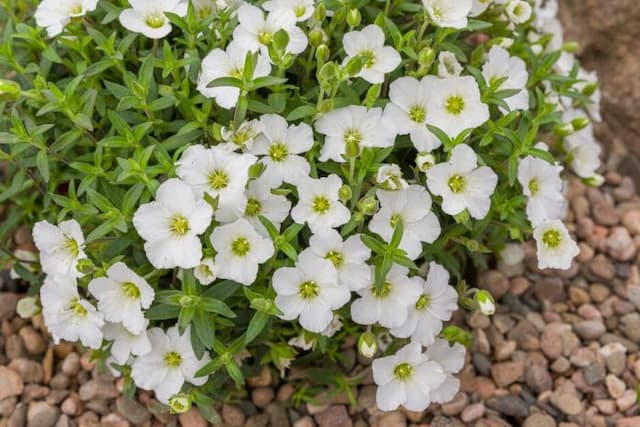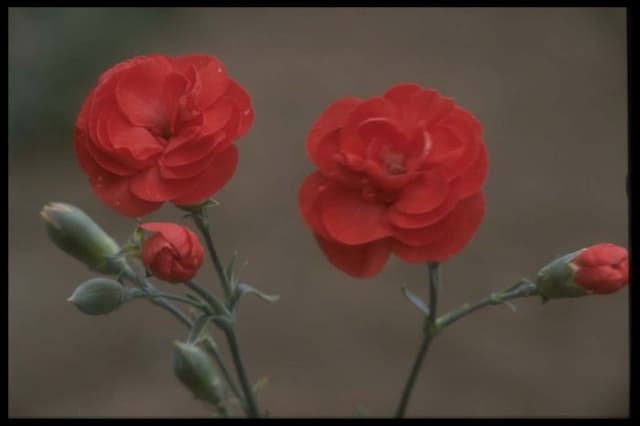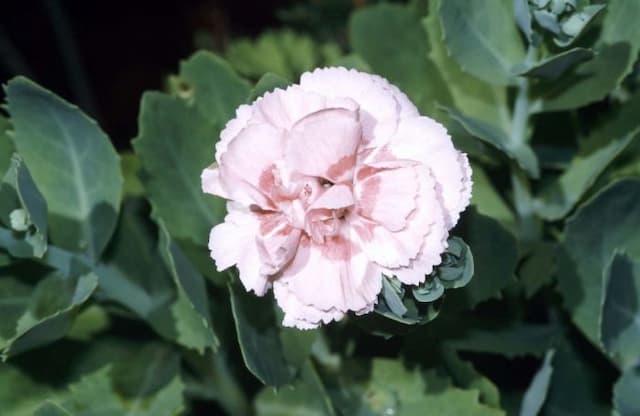Pink Dianthus Mendlesham Minx = 'Russmin' (PBR) (p)
![pink [Mendlesham Minx]](/_next/image?url=https%3A%2F%2Fplants-admin.emdemapps.com%2Fimages%2Fplants%2F%2Fimages%2F604b55b2afa97.png&w=3840&q=75)
ABOUT
The Dianthus Mendlesham Minx, also known as 'Russmin', displays a striking appearance with a lush foliage base from which its vibrant flowers emerge. The foliage typically has a grey-green color, forming a neat, cushion-like mound. This provides a beautiful contrast to the blooms. The flowers of this cultivar are particularly eye-catching, characterized by their fringed petals that create a somewhat ruffled look. Each petal exhibits a rich pink tone, which may vary in intensity across different flowers or even within a single bloom. At the center, the petals often present a darker hue or contrasting eye that can give each flower a unique appearance, drawing in viewers for a closer look. The overall floral display is bright and vivid, with the blossoms grouped together in clusters, creating a dense, colorful coverage over the foliage when in full bloom. This Dianthus variety is appreciated not only for its ornate flowers but also for the pleasant fragrance they emit, adding an additional layer of sensory appeal to the garden space where it resides.
About this plant
 Names
NamesSynonyms
Mendlesham Minx, Border Pinks
Common names
Dianthus 'Mendlesham Minx', Dianthus 'Russmin'
 Toxicity
ToxicityTo humans
The plant commonly known as Dianthus is not generally considered toxic to humans. There have been no widely reported adverse effects from ingesting parts of this plant. However, as with many plants, individual sensitivities can occur, and it is always best to avoid eating ornamental plants due to potential unknown toxins or the application of pesticides and herbicides.
To pets
Dianthus is also not known to be toxic to pets. This common garden flower does not typically cause poisoning in dogs, cats, or other domestic animals if they ingest its parts. Always monitor pets in gardens since individual reactions can differ, and ingestion of non-food items can sometimes lead to gastrointestinal upset.
 Characteristics
CharacteristicsLife cycle
Perennials
Foliage type
Evergreen
Color of leaves
Green
Flower color
Pink
Height
1 foot (30 cm)
Spread
1 foot (30 cm)
Plant type
Herb
Hardiness zones
5
Native area
Europe
Benefits
 General Benefits
General Benefits- Attractive Blooms - The Dianthus 'Mendlesham Minx' features eye-catching pink flowers with fringed petals that add color and visual interest to gardens.
- Drought Tolerance - Once established, they are quite resilient in dry conditions, making them suitable for water-wise gardening practices.
- Long Flowering Period - This variety of Dianthus tends to have a lengthy blooming period, often from late spring through early fall, providing extended garden color.
- Low Maintenance - The plant requires minimal care beyond the occasional deadheading to promote further blooming and general upkeep.
- Pest Resistance - 'Mendlesham Minx' is known to be relatively resistant to common garden pests, reducing the need for chemical treatments.
- Cold Hardy - This plant is capable of surviving and thriving in colder climates, making it a versatile choice for gardens in a variety of zones.
- Compact Size - Its size makes it suitable for use in smaller gardens, containers, or as border edging without overpowering the space.
- Fragrant Flowers - The blooms are known to have a pleasant fragrance that can add an extra layer of enjoyment to your outdoor space.
- Attracts Pollinators - The flowers can attract butterflies, bees, and other beneficial pollinators, helping to support biodiversity.
- Versatile Use - Ideal for use in rock gardens, containers, borders, and as cut flowers for indoor arrangements.
 Medical Properties
Medical PropertiesThis plant is not used for medical purposes.
 Air-purifying Qualities
Air-purifying QualitiesThis plant is not specifically known for air purifying qualities.
 Other Uses
Other Uses- As a natural dye: The Dianthus Mendlesham Minx can provide a range of pink hues depending on the mordant used, for dyeing fabrics and yarns.
- Eco-printing: The flowers of the plant can be used for eco-printing techniques to transfer their shapes and colors onto paper or fabric.
- Edible decorations: The petals of this flower are edible and can be used to add a splash of color to salads, desserts, and cocktails.
- Garden art: Dried flowers can be used in crafting activities, such as creating bookmarks, greeting cards, or pressed flower arrangements.
- Natural confetti: Dried petals can serve as biodegradable confetti for weddings or celebrations.
- Perfumery: The flowers can be used in homemade potpourris to scent rooms or in sachets for drawers and closets.
- Floral water: Petals can be steeped in water to make a floral-scented water for face rinsing or adding a light fragrance to linens.
- Plant dye art: Using the petals for botanical printmaking or ink-making can be a creative and unusual art form.
- Culinary sugar: The petals can be crystallized with sugar to create floral decorations that can be eaten or used to embellish baked goods.
- Decorative ice cubes: Freezing petals in ice cube trays for decorative ice cubes is a unique way to enhance drinks for special events.
Interesting Facts
 Feng Shui
Feng ShuiThe plant Dianthus is not used in Feng Shui practice.
 Zodiac Sign Compitability
Zodiac Sign CompitabilityThe plant Dianthus is not used in astrology practice.
 Plant Symbolism
Plant Symbolism- Love: Dianthus, commonly known as "Carnation" or "Pinks," often symbolizes love and affection, particularly in a romantic sense, with its vibrant hues and sweet fragrance.
- Admiration: Carnations carry the meaning of admiration, expressing respect and high regard for someone.
- Distinction: The name "Dianthus" originates from Greek, meaning 'divine flower,' indicating the plant's association with nobility and excellence.
- Pure Love: White varieties in particular are associated with pure love and good luck.
- Gratitude: Carnations can symbolize gratitude, making them a fitting choice for gifts when one wants to show appreciation.
- Fascination: The flower also represents fascination and captivation, conveying that the object of one's affection is mesmerizing.
- Devotion: Pink carnations especially are tied to a mother's undying love, signifying deep emotional bonds and commitment.
 Water
WaterPink Kisses, the common name for Dianthus Mendlesham Minx, should be watered thoroughly whenever the top inch of the soil feels dry to the touch. This may mean watering every few days during hot, dry periods or as infrequently as once a week during cooler, wetter weather. Apply water directly to the base of the plant, avoiding wetting the foliage, as Dianthus prefer not to have their leaves remain wet, which could promote fungal diseases. It's important not to over-water, as this plant is prone to root rot in soggy soil. In general, provide approximately one gallon of water per plant each time you water, adjusting as necessary for your local weather conditions.
 Light
LightPink Kisses thrive best in full sun, where they can receive at least six hours of direct sunlight every day. They can tolerate some light shade, especially in the hottest parts of the day, but too much shade will reduce their blooms and vigor. The ideal spot for Pink Kisses is in a position where they can soak up the morning sun and are protected from harsh afternoon rays in extremely hot climates.
 Temperature
TemperaturePink Kisses can survive in a temperature range from 40°F to 80°F. However, temperatures hovering around 60°F to 70°F are ideal for them. They endure cold down to about 40°F, but frost is not advisable. During hot periods, maintain consistent watering to help the plant cope with temperatures that exceed 80°F.
 Pruning
PruningPink Kisses should be pruned to encourage bushier growth and more flowers. Deadhead spent flowers regularly to promote continuous blooming throughout the season. After the first wave of blooming, cut the plant back by one-third to stimulate a second flush of flowers. The best time for a major pruning is in early spring or after the plant has finished blooming in the fall.
 Cleaning
CleaningAs needed
 Soil
SoilCarnations, such as the Dianthus 'Mendlesham Minx', thrive in well-draining, loamy or sandy soil with a pH of 6.0 to 7.5. A mix with organic compost and slight alkalinity is ideal for optimal growth and flowering.
 Repotting
RepottingCarnations should be repotted every 2-3 years to refresh the soil and prevent root crowding, ensuring the health and vigor of the plant.
 Humidity & Misting
Humidity & MistingCarnations prefer moderate humidity levels; misting can help maintain humidity without overwatering.
 Suitable locations
Suitable locationsIndoor
Ensure bright light, well-draining soil, and infrequent watering for indoor carnations.
Outdoor
Plant in full sun, in well-draining soil, and space adequately for airflow.
Hardiness zone
3-9 USDA
 Life cycle
Life cycleThe Dianthus 'Mendlesham Minx', typically referred to as Pinks or Carnation 'Mendlesham Minx', starts its life cycle when seeds are sown or when cuttings are rooted, ideally in late spring to early summer. After germination or rooting, the plant enters a vegetative growth stage, developing a rosette of linear, blue-green leaves and establishing a strong root system. As it matures, usually within the first year, it begins to produce sturdy flowering stems that bear the distinctive, highly fragrant flowers, which can be pink, red, white, or multicolored depending on the variety. Flowering generally occurs in late spring to early summer and can continue intermittently until early fall, attracting pollinators such as bees and butterflies. Following pollination, the plant may produce small, dry seed capsules containing numerous seeds that can be collected for propagation or allowed to self-sow. The plant is perennial, enduring through multiple seasons with proper care, and after flowering, it often enters a period of dormancy in the winter before resuming growth in the spring.
 Propogation
PropogationPropogation time
Spring-Early Summer
Propogation: Dianthus Mendlesham Minx, commonly known as pinks or carnations, is typically propagated by cuttings. The best time for taking cuttings is late spring to early summer when the plant is growing vigorously. To propagate, a gardener should select a non-flowering shoot and cut a section that is about 3-4 inches (7.5-10 cm) long. The lower leaves are removed and the cut end is then dipped into rooting hormone to encourage root growth, although this step isn't always necessary. The cutting is placed in well-draining soil, and it should be kept moist but not waterlogged. Over the following weeks, roots will develop, and eventually, new growth will indicate that the cutting has successfully rooted. It's important to keep the young plants sheltered until they are strong enough to be planted out.



![Pink [Tequila Sunrise]](/_next/image?url=https%3A%2F%2Fplants-admin.emdemapps.com%2Fimages%2Fplants%2F%2Fimages%2F604b5d995d06e.png&w=640&q=75)





